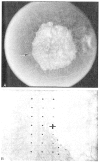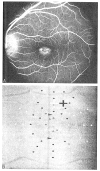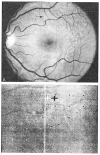Fixation patterns and reading rates in eyes with central scotomas from advanced atrophic age-related macular degeneration and Stargardt disease
- PMID: 8841306
- PMCID: PMC2730505
- DOI: 10.1016/s0161-6420(96)30483-1
Fixation patterns and reading rates in eyes with central scotomas from advanced atrophic age-related macular degeneration and Stargardt disease
Abstract
Purpose: To study fixation patterns and reading rates in eyes with central scotomas from geographic atrophy (GA) of age-related macular degeneration and to compare fixation patterns with those of patients with Stargardt disease.
Methods: Scanning laser ophthalmoscope analysis of fixation patterns in eyes with 20/80 to 20/200 visual acuity. Included were 41 eyes of 35 patients with GA and 10 eyes of 5 patients with Stargardt disease. The patients with GA also were tested for maximum reading rate, and the size of the areas of atrophy were measured by fundus photograph analysis.
Results: Sixty-three percent of GA eyes fixating outside the atrophy placed the scotoma to the right of fixation in visual field space, 22% placed the scotoma above fixation, and 15% placed it to the left, regardless of the laterality of the GA eye. Fixation was stable in subsequent years of testing for scotoma placement to the right of or above fixation. All GA eyes fixated immediately adjacent to the atrophy. In contrast, seven of ten eyes with Stargardt disease fixated at a considerable distance from the scotoma border, with the dense scotoma far above the fixation site in visual field space. For the patients with GA, the maximum reading rate was highly correlated with size of the atrophic area, but not with age or visual acuity within the limited visual acuity range tested. There was a trend to more rapid reading with the scotoma above fixation and slower reading with the scotoma to the left.
Conclusion: There is a preference for fixation with the scotoma to the right in eyes with GA. Patients with Stargardt disease use different strategies for fixation, perhaps due to subclinical pathology adjacent to the atrophic regions. The size of the atrophic area in GA plays the predominant role in reading rate for eyes that have already lost foveal vision.
Conflict of interest statement
The authors have no proprietary interest in the development or marketing of any product mentioned in this article.
Figures






Similar articles
-
Long-term follow-up of fixation patterns in eyes with central scotomas from geographic atrophy that is associated with age-related macular degeneration.Am J Ophthalmol. 2005 Dec;140(6):1085-93. doi: 10.1016/j.ajo.2005.07.040. Am J Ophthalmol. 2005. PMID: 16376656 Free PMC article.
-
Visual function abnormalities and prognosis in eyes with age-related geographic atrophy of the macula and good visual acuity.Ophthalmology. 1997 Oct;104(10):1677-91. doi: 10.1016/s0161-6420(97)30079-7. Ophthalmology. 1997. PMID: 9331210 Free PMC article.
-
Characteristics of visual loss by scanning laser ophthalmoscope microperimetry in eyes with subfoveal choroidal neovascularization secondary to age-related macular degeneration.Am J Ophthalmol. 2003 Dec;136(6):1067-78. doi: 10.1016/s0002-9394(03)00663-9. Am J Ophthalmol. 2003. PMID: 14644217
-
Preferred retinal loci and macular scotoma characteristics in patients with age-related macular degeneration.Can J Ophthalmol. 2005 Jun;40(3):303-12. doi: 10.1016/S0008-4182(05)80073-0. Can J Ophthalmol. 2005. PMID: 15947800 Review.
-
The Progression of Geographic Atrophy Secondary to Age-Related Macular Degeneration.Ophthalmology. 2018 Mar;125(3):369-390. doi: 10.1016/j.ophtha.2017.08.038. Epub 2017 Oct 27. Ophthalmology. 2018. PMID: 29110945 Review.
Cited by
-
Relationship of Topographic Distribution of Macular Atrophy Secondary to Neovascular AMD and Reading Performance.Invest Ophthalmol Vis Sci. 2024 Jan 2;65(1):44. doi: 10.1167/iovs.65.1.44. Invest Ophthalmol Vis Sci. 2024. PMID: 38289615 Free PMC article.
-
Functional and cortical adaptations to central vision loss.Vis Neurosci. 2005 Mar-Apr;22(2):187-201. doi: 10.1017/S0952523805222071. Vis Neurosci. 2005. PMID: 15935111 Free PMC article. Review.
-
Topical dorzolamide for treatment of cystoid macular edema in patients with choroideremia.Retina. 2012 Apr;32(4):826-33. doi: 10.1097/IAE.0b013e3182215ae9. Retina. 2012. PMID: 21886018 Free PMC article.
-
A Depth-Dependent Integrated VF Simulation for Analysis and Visualization of Glaucomatous VF Defects.Transl Vis Sci Technol. 2020 Feb 12;9(3):8. doi: 10.1167/tvst.9.3.8. Transl Vis Sci Technol. 2020. PMID: 32704428 Free PMC article.
-
Is reduction in the risk of vision loss the only benefit of photodynamic therapy in predominantly classic subfoveal choroidal neovascularization?Clin Ophthalmol. 2008 Dec;2(4):773-80. doi: 10.2147/opth.s3653. Clin Ophthalmol. 2008. PMID: 19668430 Free PMC article.
References
-
- Sarks JP, Sarks SH, Killingsworth MC. Evolution of geographic atrophy of the retinal pigment epithelium. Eye. 1988;2:552–77. - PubMed
-
- Sunness JS, Johnson MA, Massof RW, et al. Retinal sensitivity over drusen and nondrusen areas. A study using fundus perimetry. Arch Ophthalmol. 1988;106:1081–4. - PubMed
-
- Sunness JS, Bressler NM, Maguire MG. Scanning laser ophthalmoscope analysis of the pattern of visual loss in age-related geographic atrophy of the macula. Am J Ophthalmol. 1995;119:143–51. - PubMed
-
- Taylor HR, West SK. The clinical grading of lens opacities. Aust N Z J Ophthalmol. 1989;17:81–6. - PubMed
Publication types
MeSH terms
Grants and funding
LinkOut - more resources
Full Text Sources
Medical

